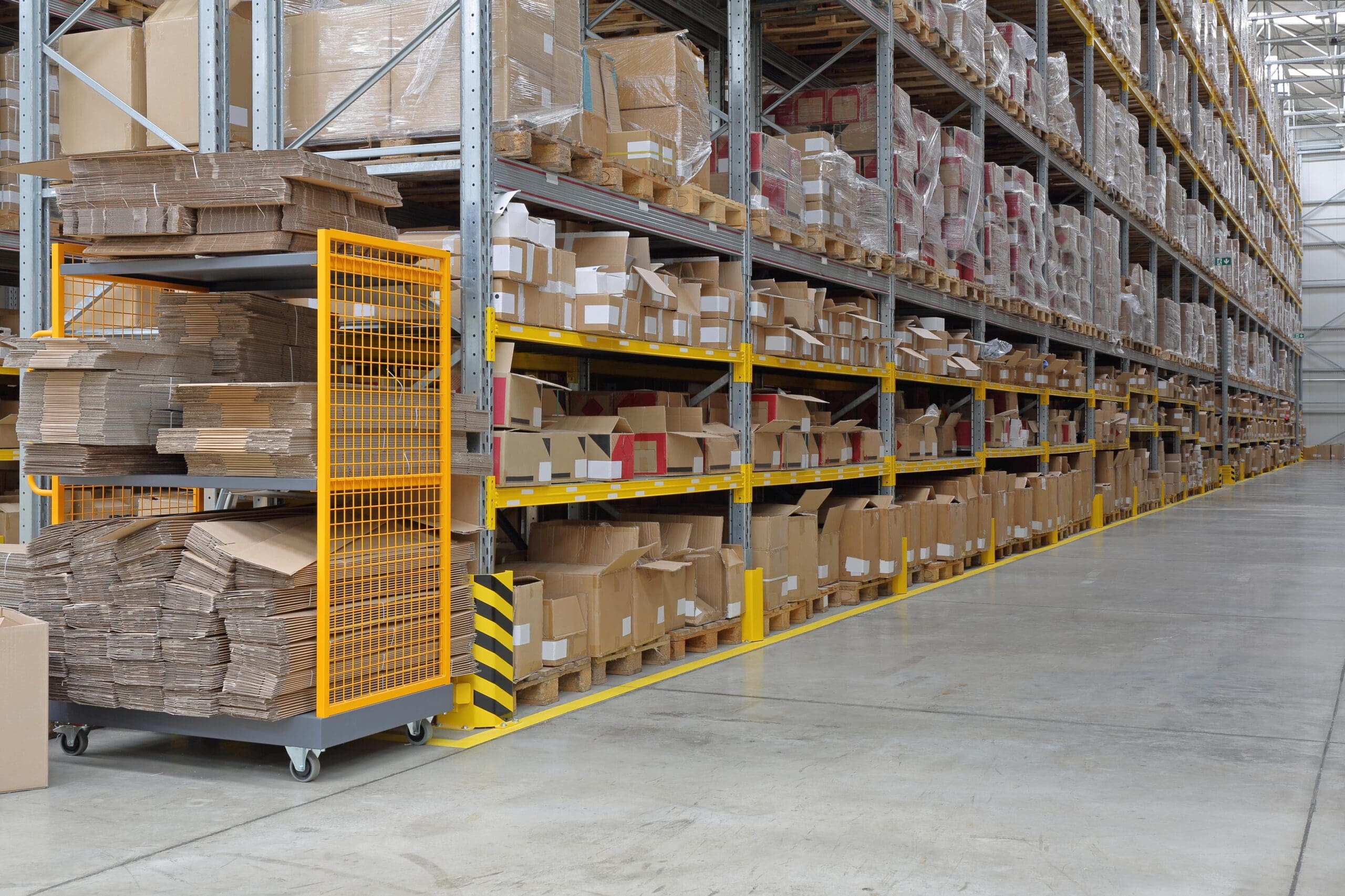Table of Contents
** Minutes
What is supply chain risk management?
What are the risks to supply chain management (and how do they come about)?
Strategies to mitigate supply chain management risks
Vulnerabilities and supply chain disruptions can result in billions of dollars of lost profit.
From product quality issues and supplier inconsistencies to security threats and lack of supply chain visibility, there are a number of factors that could pose a risk to your ecommerce supply chain.
To improve supply chain efficiency and avoid disruptions to supply chain operations, proper supply chain management involves continuous monitoring and improvement to reduce risk significantly.
Let’s dive into how today’s ecommerce businesses approach supply chain risk management.
What is supply chain risk management?
Supply chain risk management refers to the strategic process of identifying, evaluating, and mitigating factors that could pose a risk to supply chains.
These risks may be in the form of vulnerabilities, threats, and disruptions that could negatively impact supply chain performance.
For ecommerce businesses, supply chain risk management may involve partnering with reliable service providers, strengthening supplier relationships, enhancing supply chain visibility, and so on.
These efforts to mitigate risks in the supply chain can:
- Reduce costs
- Improve efficiency
- And enhance the customer experience
The problem with supply chain risk management in 2023
Supply chain technology advancements and growing knowledge may have made it easier to manage supply chain risks to a certain extent. At the same time, the risks have also grown in magnitude, particularly when it comes to cybersecurity threats.
With more data being stored virtually and more transactions taking place online, it’s no surprise that 98% of organizations have reported experiencing a cybersecurity breach that negatively impacted their supply chain.
Further, Gartner also found that 89% of companies have experienced a risk related to suppliers in the past five years.
This may be due to a number of factors with the leading one being geopolitical unrest, which was reported by 58% of business leaders, according to a SAP survey. Lack of raw materials was the second most common risk (44%), followed by the rising cost of fuel and energy (40%).
Speaking or rising costs, with inflation affecting the global economy, it’s also posing a significant risk to ecommerce supply chains. 31% percent of business leaders in the SAP survey reported it as a major contributor of issues in their supply chain.
However, Gartner also reported that there’s a lack of awareness among organizations about these risks. On top of this, companies aren’t yet doing enough to mitigate risks in the supply chain.
What are the risks to supply chain management (and how do they come about)?
So what are the exact risks that can threaten supply chain management and how are they caused? Let’s take a closer look.
Volatile macroeconomic environments
Global economic conditions such as recessions and inflation can create volatile environments that pose a risk to supply chain management.
As a result of these environments, businesses may experience sudden price hikes and higher operational costs that can get in the way of your supply chain planning.
Moreover, there may be raw material shortages that will then result in supply chain bottlenecks as businesses are unable to procure inventory to keep up with demand.
On the flip side, a global recession may slow down demand as consumers are spending less money. That means companies will need to appropriately adjust their production and procurement so as to avoid excess stock and piling up surplus inventory.
It’s also important for businesses to implement advanced supply chain forecasting methods along with real-time inventory tracking to stay on top of changes and disruptions caused by economic conditions.
Unreliable and incomplete data (poor data management)
Having access to accurate and relevant information in real time is key in making informed supply chain management decisions in a timely manner.
Any missed details or inaccuracies can pose significant risks to your supply chain management as you don’t have the complete picture to make an informed decision.
Unfortunately, since your data typically comes from multiple sources, it’s easy for the information to be either incomplete or inaccurate. Beyond your own supply chain analytics data, you may get additional data from logistics partners, suppliers, customers, product developers, IoT, and so on.
It’s important for businesses to ensure that all this data is integrated and standardized to ensure better consistency and provide reliable and comprehensive insights.
Supply and product quality complaints
There are a lot of risks that can occur during product sourcing. Supply shortages, for example, can affect inventory flow further down the chain and may eventually lead to poor customer experience. It also means you might be unable to source enough inventory on time to meet consumer demand.
A decline in the overall product quality also poses a serious threat to your supply chain management and would require immediate action. You may experience quality issues when switching between suppliers or because of changes made by the supplier.
Alternatively, issues in procurement logistics and transportation may also lead to product quality issues. For example, delays in transit may affect the quality of perishable items.
Chain-wide service disruption (weather events, strikes, layoffs, etc.)
There are risks associated with disruptions that affect the entire supply chain and may lead to decreased supply chain volatility. Unexpected disruptions such as weather events and natural disasters are a leading cause of risks in supply chain management.
Additionally, strikes and layoffs can create bottlenecks as they slow down the speed at which different processes are carried out.
The best way for businesses to prevent these chain-wide disruptions is by boosting supply chain resilience. This would allow them to quickly bounce back by anticipating unexpected events, which would then mitigate supply chain management risks.
Strategies to mitigate supply chain management risks
There are a number of steps that businesses can take to mitigate risks that can affect their supply chain management.
Let’s explore some of the key strategies.
Improve supply chain visibility
Access to comprehensive, reliable, and real-time information throughout the supply chain is one of the key steps to mitigating risk.
When you have better supply chain visibility, you can see exactly how different areas of the chain are functioning. This allows you to detect patterns and trends so you can identify potential risks and mitigate them before they turn into bigger issues.
Make use of automation
Supply chain automation can significantly improve the speed at which different tasks are performed and completed. This allows inventory to move seamlessly throughout the supply chain with minimal delays, which can reduce costs and improve customer experience.
Automation also decreases the risk of human error, which is a common cause of delays and disruptions.
Increase supply chain agility
An agile supply chain means you have the ability to quickly react to any changes in the market, which gives you better protection in times of unexpected disruptions. Increasing your supply chain agility is a key step to minimizing supply chain management risks.
Some of the best ways to improve agility:
- Planning and setting inventory reorder points
- Tracking real-time data and pulling inventory reports consistently
- Relying on strategic inventory distribution
- Partnering with an omnichannel fulfillment provider
Enhance demand forecasting and planning
One of the most effective ways to mitigate supply chain management risk is by having an accurate idea of demand and planning your procurement accordingly. This will help you get ahead of demand fluctuations and supply chain disruptions so you can maintain the right inventory levels to keep up with demand.
For instance, you can increase your procurement if you suspect a surge in demand in the near future. Or you may decrease your reorder volume if you notice a downward trend in demand.
It’s important to accurately forecast demand and stay on top of trends and market changes that could influence it. This will help you reduce inventory risk throughout your supply chain.
How a 3PL can help reduce supply chain risks
Reducing supply chain management risk is a challenging process, which is why it’s not uncommon for ecommerce businesses to partner with a reliable third-party logistics (3PL) provider.
Third-party fulfillment services gives ecommerce businesses access to fulfillment locations and technology that enables you to save time and money while reducing risks.
ShipBob is an omnichannel fulfillment provider that offers everything from affordable 2-day shipping to global fulfillment.
2-day shipping
Long transit times can result in customer disappointment. Moreover, the longer shipments take to travel from your warehouse or fulfillment center to the customer’s doorstep, the higher the chance of additional transit delays. Your orders become at risk of being affected by unexpected disruptions.
With ShipBob’s 2-day express fulfillment solution, you’re given 100% 2-day shipping coverage across the continental US. This enhances customer satisfaction while reducing risk during last-mile delivery.
We used to have a lot more complaints with 2-day shipping before partnering with ShipBob, but with our inventory strategically distributed, we can cut lead times and really follow through on the 2-day promise.
It also helps that ShipBob isn’t locked to a specific carrier for 2-day service, and instead partners with a bunch of different carriers to find the best rate and most optimal route.
Mithu Kuna, Co-Founder and CEO of Baby Doppler
Global expansion and scaling
Expanding your business globally involves growing the scale of your operations, which significantly increases possible risks in the supply chain. It leaves you more susceptible to changes in global markets and economic environments as well as other unexpected disruptions.
With ShipBob, you can take advantage of a global fulfillment network to simplify international fulfillment and shipping for customers in the U.S., the U.K., Canada, Europe, and Australia.
ShipBob also offers a top-tier DDP shipping solution, which helps businesses prevent long delivery times and surprise fees for consumers, providing a frictionless, loyalty-building international shipping experience.
“It just so happened that around the time we were looking for a new partner, ShipBob reached out to us. As we did our research, we saw ShipBob had fulfillment centers in all of the areas we wanted to be in, and they were still growing quickly.
Choosing to partner with ShipBob for our global fulfillment was easy – ShipBob had exactly what we were looking for.”
Adam LaGesse, Global Warehousing Director at Spikeball
Omnichannel and B2B supply chains
More and more ecommerce businesses are expanding into multichannel retailing and striking up partnerships with leading retailers, which is great for business but can make the supply chain all the more complex to manage.
Companies may struggle to keep track of and fulfill orders coming from multiple channels all while trying to establish a strong relationship with their retail customers.
ShipBob offers robust omnichannel fulfillment solutions to address this major challenge. ShipBob’s cloud-based fulfillment software integrates with your online store and other virtual storefronts, which allows you to keep track of and process all your online orders in one place — no matter the source.
ShipBob also plays a vital role in B2B ecommerce with services in fulfilling wholesale orders for retail partners. That way, you can easily sell your products through leading retailers and ensure that orders placed through their websites are fulfilled efficiently.
Retail dropshipping and retail distribution solutions
With ShipBob’s retail distribution solutions, you can ensure compliance with all retailer requirements so as to avoid expensive chargebacks. The automated solution helps you streamline your distribution efforts without the need to switch between multiple tools, which will minimize the risk of errors and speed up the process.
Alternatively, you can use ShipBob’s retail dropshipping solution to fulfill orders directly without sending your inventory to retailers. That way, you still get to make use of the retailer’s expansive buyer network while maintaining control over the fulfillment aspect.
This is a great way to mitigate supply chain risks since you can cut down on the extra steps that could leave you more vulnerable to disruptions, delays, and other issues.
“We also stock several hundred smaller boutique wholesales across the country. We recently started selling through a few major retailers, including Kohl’s and Francesca’s.
It’s going really well! ShipBob’s B2B Fulfillment Suite powers retail dropshipping and retail distribution for other retailers that we’re hoping to partner with in the future, including Target and Walmart, so we’re excited to keep expanding our retail partnerships with ShipBob.
Retail is looking like it will be a huge focus for us in the coming years, and we’re hoping that with ShipBob’s help, it will continue to be a larger and larger part of our business.”
Aaron Patterson, COO of The Adventure Challenge
Apps and APIs
ShipBob can offer an all-in-one fulfillment tech stack when you take advantage of its range of integrations.
The software integrates with leading ecommerce apps and marketplaces so you can carry out all your fulfillment activities in one place.
It supports integrations with all kinds of ecommerce apps for every stage of your supply chain. Moreover, you can use the REST API to interface with your own websites, ERPs, and marketplaces.
When we came across ShipBob’s Developer APIs, it was game over. We could build custom code from our proprietary platform to ShipBob’s, and have ShipBob fulfill all those orders. We built an integration directly into ShipBob, so our clients would have a seamless experience.
Pre-COVID, we were all accustomed to walking into a supply closet, pulling out a FedEx envelope, stuffing it with an item, and sending it out. Now with Postal and ShipBob, our clients can log in to the Postal dashboard, make a click or two, and the item gets sent out in 3-5 business days.
Ben Jablow, VP, Alliances at Postal
Fulfillment software
ShipBob’s powerful fulfillment software improves speed and order accuracy to reduce errors. It integrates with your store and automatically processes any order that has been placed.
Order information is automatically pulled from your system, which minimizes the risk of errors related to manual order entry. Each order is then moved along to the next stage of fulfillment, where picking lists are generated based on optimal picking routes to speed up the process.
The software gives you full visibility into your inventory levels so you can have real-time updates, so you can stay on top of SKU management and inventory replenishment. Moreover, it also lets you set reorder point notifications, so you get alerted as soon as your stock dips below a certain level.
The fulfillment software can even be used to make informed decisions about optimal distribution strategies so you can distribute your inventory across multiple fulfillment centers based on regional demand.
“We love all the features of ShipBob’s dashboard. We especially love the timeline feature, which shows which orders are processed, which are labeled, which are shipped, and so on.
You can track orders all the way through the supply chain to your customer’s doorstep, and get full visibility into the fulfillment process.”
Maria Osorio, Logistics and Operations Director at Oxford Healthspan
Warehouse management system
ShipBob’s warehouse management system (WMS) gives you real-time visibility into your warehousing operations and serves as a single point of truth for all your warehousing processes.
This allows for better information accuracy and standardization, which is necessary to mitigate risk. You can use the WMS to get location-specific visibility and make intelligent cycle counts to further improve accuracy.
Not ready to partner with a fulfillment provider? ShipBob offers the option to integrate the WMS technology into your warehouse, so you an scale your in-house fulfillment operations.
“ShipBob’s WMS has turned out to be exactly what I hoped it would be. They have built a really robust software system that does a fantastic job at running warehousing and fulfillment operations.
Once your team is trained on the system (which takes a few hours at most), it becomes easy to set things on autopilot and establish a repeatable process.”
Ben Tietje, Co-Founder and CEO of Earthley
Freight
ShipBob’s FreightBob solution is exactly what you need to improve the speed and reliability of freight coming from China.
ShipBob’s freight solution helps you to reduce transit times and increase visibility, which empowers you to minimize risks associated with international freight and imports.
“Our sales for BFCM exceeded expectations — so we were lucky that we had FreightBob to deliver extra inventory so quickly, including the ocean freight portion that they orchestrated with Flexport.
We were super well-stocked for the rest of the year and then into the start of this year, without any of the inventory issues that have plagued us in the past.”
Nathan Garrison, Co-Founder and CEO of Sharkbanz
Ready to learn more about ShipBob? Click the button below to receive more information and pricing.
Supply chain risk management FAQs
Below are answers to the most common questions about supply chain risk management.
What is supply chain risk management?
Supply chain risk management refers to the strategic process of identifying, evaluating, and mitigating factors that could pose a risk to the supply chain.
What are the main risks of the supply chain?
Volatile macroeconomic environments, supply shortages, product quality issues, unreliable and incomplete data, and unexpected chain-wide disruptions are the main risks to the supply chain.
What is the first step in supply chain risk management?
Identifying common risks is the first step in supply chain risk management. This can be done by implementing real-time tracking software into your warehouse operations, so you can identify areas of your supply chain that need improvement.
What is the difference between supply chain risk and a supply chain issue?
A supply chain issue is something that’s already affecting the supply chain whereas a supply chain risk is something that could cause a possible issue further down the line.



